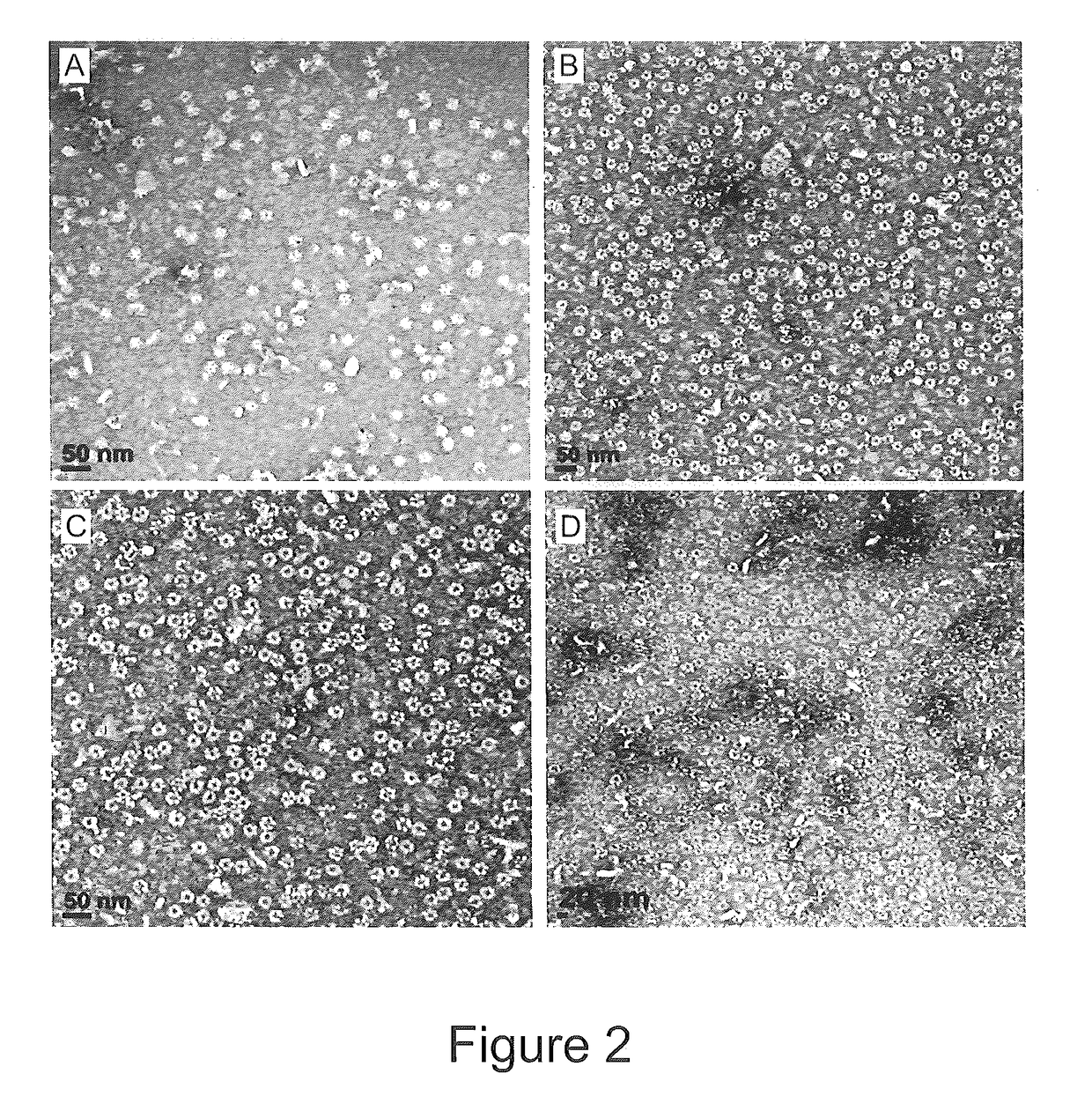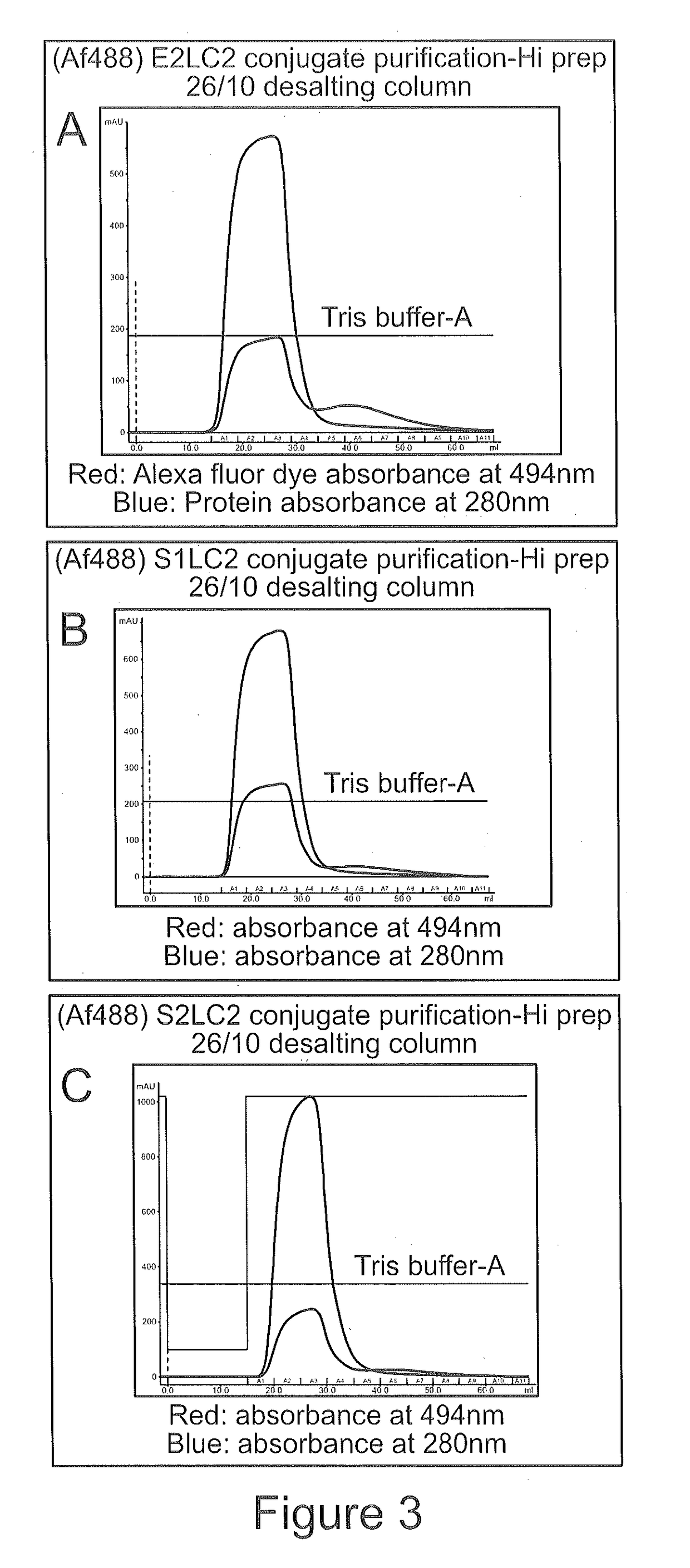Targeting of melanocytes for delivering therapeutic or diagnostic agents using protein nanocages
a technology of protein nanocages and melanocytes, which is applied in the direction of peptide/protein ingredients, peptide sources, drug compositions, etc., can solve the problems of current therapies, pigmentation disorders such as melasma, and suffer from current therapies
- Summary
- Abstract
- Description
- Claims
- Application Information
AI Technical Summary
Benefits of technology
Problems solved by technology
Method used
Image
Examples
example 1
Construction of Plasmids Encoding SPACE1-E2LC2, SPACE2-E2LC2 and αMSH-E2LC2 Fusion Proteins
[0095]The amino acid sequences of SPACE1-E2LC2 (S1LC2; SEQ ID NO:14), SPACE2-E2LC2 (S2LC2; SEQ ID NO:15) and αMSH-E2LC2 (SEQ ID NO:16) fusion proteins were codon optimized using a tool from Integrated DNA Technologies, Inc (http: / / eu.idtdna.com / CodonOpt). The pSMART plasmids encoding said fusion proteins were purchased from the same company and digested by NdeI and BamHI restriction enzymes. Subsequently, the DNA fragments encoding the fusion proteins were purified and subcloned into the pET11a plasmid. Escherichia coli-DH5α and Escherichia coli-BL21(DE3) competent cells were then transformed with the ligated plasmids and plated in LB agar plates supplemented with ampicillin (100 mg / mL) and incubated at 37° C. for 16 hours. Single clones from E. coli BL21 (DE3) agar plates were isolated and inoculated in 20 mL LB medium as the starter culture before being transferred to 1 L cultures for large ...
example 2
Production and Characterization of Protein Nanocages
[0096]Protocols for the production and purification of E2 protein used in the present application had been previously reported (Dalmau M, et al. Biotechnol Bioeng. 2008 Nov. 1; 101(4):654-64). E. coli BL21 (DE3) cells were transformed with pET11a plasmids encoding E2LC2, S1LC2, S2LC2 or αMSH-LC2. The 20 ml starter culture of cells were grown overnight and inoculated in 1 L of LB medium. The cells were treated with 1 mM IPTG to overexpress the proteins when the OD value reached 0.6-0.8. After 4 hours cells were harvested by centrifugation at 4,700 g for 30 minutes. Harvested cells were resuspended in a buffer (20 mM Tris, 5 mM EDTA and 0.02% sodium azide) and ultrasonicated by Vibracell VC 750 Ultrasonic Cell Disrupter at 37% amplitude for 20 minutes with pulse on and off for 5 seconds. The sonicated solution was heat-treated at 75° C. for 15 minutes and was ultracentrifuged at 193,011 g for 1 hour. The supernatant was then collecte...
example 3
Conjugation of Protein Nanocages with Alexa Fluor 488 Fluorescent Dye
[0097]The purified proteins were conjugated with thiol reactive Alexa Fluor 488 (AF488) dye for convenience of detection and quantification. The E2LC2, S1LC2, S2LC2 and αMSH-LC2 protein nanocages were incubated with 10 mM excess tris carboxy ethyl phosphine (TCEP) for 1 hour to reduce the 120 cysteine residues residing inside the protein nanocages. The reduced proteins were reacted with 50 molar excess of Alexa Fluor 488 dye at room temperature for 2 hours and subsequently at 4° C. for 20 hours at pH 7.0. After the conjugation reaction, the dye-conjugated protein nanocages were purified by gel filtration chromatography using Hi prep 26 / 10 desalting column by FPLC. The samples were spun down at 12,000 g for 15 minutes after the conjugation reaction. The pellet fraction was discarded and the supernatant was collected and loaded onto the desalting column with elution buffer (20 mM Tris, 5 mM EDTA and 0.02% sodium azid...
PUM
| Property | Measurement | Unit |
|---|---|---|
| Therapeutic | aaaaa | aaaaa |
Abstract
Description
Claims
Application Information
 Login to View More
Login to View More - R&D
- Intellectual Property
- Life Sciences
- Materials
- Tech Scout
- Unparalleled Data Quality
- Higher Quality Content
- 60% Fewer Hallucinations
Browse by: Latest US Patents, China's latest patents, Technical Efficacy Thesaurus, Application Domain, Technology Topic, Popular Technical Reports.
© 2025 PatSnap. All rights reserved.Legal|Privacy policy|Modern Slavery Act Transparency Statement|Sitemap|About US| Contact US: help@patsnap.com



